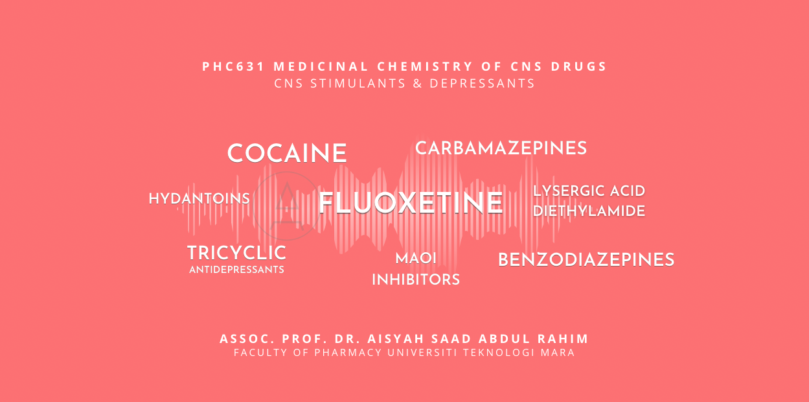Welcome to PHC631 CNS Drugs
Assalamualaikum and Hello everyone!
There are three parts to my lectures on CNS Drugs. You’ll find the resources for learning about the CNS drugs presented in the form of:
1. the Padlet below
2. the long document (with a list of drugs)
3. the purple PDF word cloud
If you’d like to do well in exams and later in practice, I suggest you go through all the essential materials (the purple PDF) and the additional resources.
1. Categories of CNS Drugs
The CNS drugs can be divided into two broad categories: CNS Stimulants and CNS Depressants. Each refer to its general mode of drug action in the CNS: the former is to stimulate certain regions in the brain; they cause excitations (alertness, elevate moods) and bring about peripheral muscle actions.
On the contrary, drugs grouped under CNS Depressants bring about alleviation of excessive excitatory stimulation or provide some form of inhibition to abnormal nerve transmissions.
CNS drugs are quite diverse in structures and their therapeutic effects. For example, benzodiazepines can act as anxiolytics and anti-epileptics. Because of the diverse mode of actions, the video lectures and discussions will focus on drugs highlighted in the following overview word cloud:
2. The long document (with a list of drugs)
The following document is meant to accompany the video lectures that include brief discussions on selected theories/hypotheses surrounding the use of the drugs, their physico-chemical properties, structure-activity relationships (SARs), pharmacokinetics, and how these elements influence a drug’s choice.
3. The purple CNS word cloud
FYI, the four hour lectures are delivered asynchronously via 13 short videos (mostly of ~15 min) over a period of 2.5 hours. I suggest you study one video at least twice everyday (now it sounds like a prescription😉). If you do so, you’d able to complete the entire playlists in two weeks. And have time for revisions plus other things*
Click on the purple media below to download the PDF. Then, click on the text in the PDF for my videos and lecture notes.
Tips – Part I
Students, you are advised to read through the recommended chapters and textbooks covering all drug examples in this tables. Videos, video lectures** and reading materials are included in the purple PDF and Padlet for background reading.
Although this is extra, your effort will help you gain deeper understanding and appreciation on the medicinal chemistry of these CNS drugs, and how it relates to pharmacology and clinical pharmacy aspects of disease management.
The knowledge will be deeply rewarding – especially when you practise as pharmacists.
Happy exploring!
*Tips – Part 2
For more effective learning, always make your own little notes after watching the videos and referring to the textbook e.g. Foye.
Cramming or binge watching may work for movies or K-drama series, but for my lecture videos on CNS drugs… well, I don’t recommend it.
Additionally, learning is about effective “absorption”, retention and retrieval. After learning the topics, I suggest you test yourself at intervals. For example: Can you list the SAR of sodium valproate?…
Check out this video by Dr. Ali Abdaal on how to study for exams.
**Note**
My video lectures and notes are strictly only for the use of PHC631 Google Classroom (20222) and hosted on my website here. For other uses including using them for MOOC and online classes, please ask my permission in writing. Thank you.
#cns #cnsdrugs #medicinalchemistry
